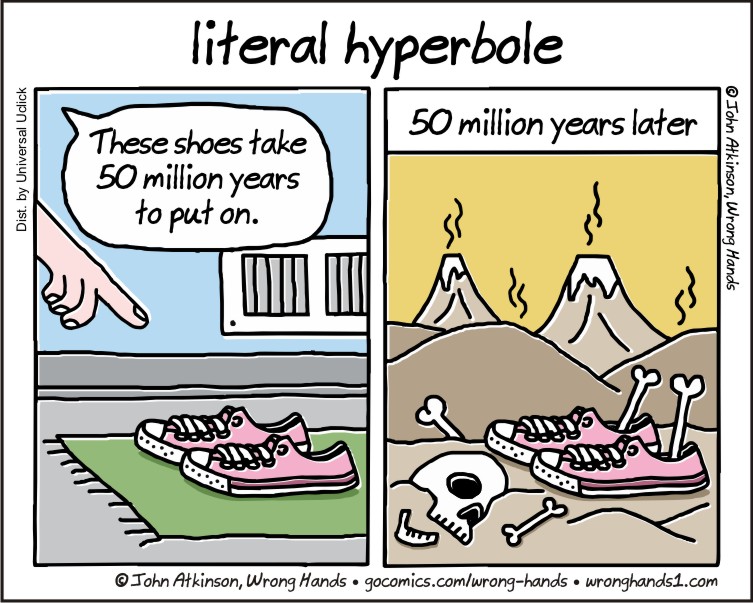Okay teachers! Put the grammar books down, and step away slowly… it’s time to teach some figurative language.

Personally, I think it is just important to introduce them to figurative language because it shows that English doesn’t have to be so stiff and rigid all the time. We can have fun with words, and paint a picture with the level of descriptiveness we use. (See my Similes and Metaphors lesson as an example).
How do I incorporate it into my lessons? I usually integrate it in with the book the students are reading at the time – such as with Harry Potter or Holes for example. There are a tonne in each, you just have to do a bit of research first.
Hyperboles

A Hyperbole is an exaggeration of ideas for the sake of emphasis, often with humour. I have included a Hyperbole Powerpoint, with some prompts students can do together in groups. You can always give them an example to help them understand better. Feel free to model the following conversation:
Me: Alright kids – let’s learn about hyperboles.
Kids: What’s that?
Me: Well – it’s an exaggeration of ideas… often to show that you are funny… have a sense of humour
Kids: Huh?
Me: Let me explain…for example. I have a CRAPTONNE of marking to do… so as a reward, I will drink a BUCKET WORTH of red wine.
If you are doing Harry Potter – give them points for the most creative hyperbole. There is also a little worksheet where they can practice writing sentences with hyperboles in them.
 Loading...
Loading...
Alliteration
Alliteration is when a series of words in a row (or close together) have the same first consonant sound. For instance: Wine Wednesday and Thirsty Thursday… Friggen Friday… hm.. there is a theme here…
The Onomatopoeias and Alliterations Powerpoint is included below. Again – this can be fun, and you can take a look at various advertisement campaigns that use alliteration as well as pop music. There are many different activities you could do with this:
- Tongue Twisters (Swedes – focus on that TH sound!)
- Worksheets
- Finding alliterations in pop music
 Loading...
Loading...
For a little extra inspiration – you can show them this MINDBLOWING Alliteration Rap one of my previous students did. This kid is going places… what a phenomenal talent he is.
Onomatopoeia
One of the best words to say in the English language… it’s so much fun. How can you introduce this concept to students? Easy! Batman! Pow! Bang! Zap! Plus… it’s an excuse to watch the original Batman series.. bring out your inner nerd guys!
I have included onomatopoeias in the Powerpoint, along with a cute little poem by my favourite poet Shel Silverstein. Wonderful writer.
Here is a little worksheet you could get the students to do afterwards. See if they can identify any onomatopoeias in the book they are currently reading.
 Loading...
Loading...
There! Thankfully, that was thoroughly thought out. I am so tired that I could sleep for a month.
Bye bye!
Recent Comments